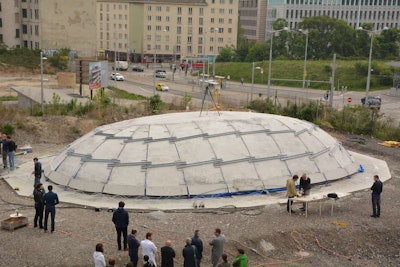
[imagebrowser id=92]
A team at the Vienna University of Technology has pioneered a new construction method they call the “Inflatable Concrete Dome.”
Just as the name implies, the method allows a crew to quickly erect a concrete dome using inflation, a process that differs greatly from how such a structure has been built in the past.
The team in Vienna says these types of structures are “hardly ever built anymore” due to the fact that they traditionally require large and costly timber support structures. The new method? “It is similar to an orange peel, which is regularly cut and then flattened out on the table”, VUT professor Johann Kollegger said in a prepared statement. “We do it the other way around, starting with a flat surface and then bending it to a shell.”
The process starts by laying out an inflatable air cushion, the blue material you see in the photos. Then, atop the cushion, flat sections of rebar are laid in the shape of the dome forming several segments. Wedge-shaped spaces are left between the segments so that when everything is inflated, the segments fit together.
Concrete is the poured in each of the segments and once it has hardened, metal beams are attached to the sections and a steel cable is laid around the outside to ensure everything moves as a cohesive unit once the air starts flowing. When the the air cushion is inflated, the air begins lifting the segmented slab up from the center, while the steel cable is tightened around the concrete segments at the same time, pushing it together from the outside.
The team has successfully tested the method, building a concrete dome 10 feet high in about two hours. The method is capable of erecting domes with a diameter up to 164 feet. Kollegger says that while cracks can be seen in the concrete sections after inflation, the structure is stable, adding that it can be plastered, giving it the same stability as a concrete shell construction in the traditional way.
Plus, Kollegger says his team’s method cuts the construction cost of such structures in half and the savings increase as the size of the dome increases.









